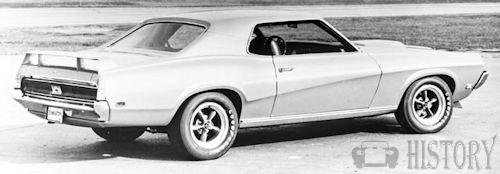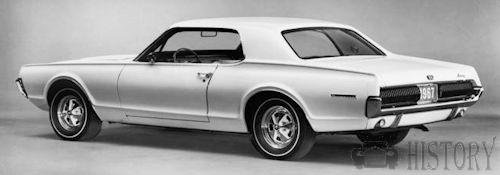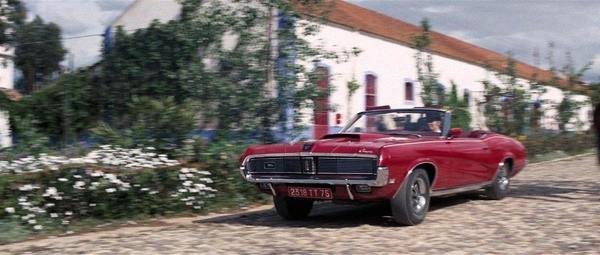Mercury Cougar First generation
| 1967–1970 | |
|---|---|
 |
|
| Overview | |
| Model years | 1967–1970 (1969–70 are the second body shape) |
| Assembly | United States: Dearborn, Michigan |
| Body and chassis | |
| Body style | 2-door hardtop coupe 2-door convertible |
| Layout | FR layout |
| Related | Ford Mustang |
| Powertrain | |
| Engine | 289 cu in (4.7 L) Windsor V8 390 cu in (6.4 L) FE V8 302 cu in (4.9 L) Windsor V8 351 cu in (5.8 L) Windsor V8 428 cu in (7.0 L) FE V8 427 cu in (7.0 L) FE V8 |
| Dimensions | |
| Wheelbase | 111 in (2819 mm) |
The introduction of the Cougar finally gave Mercury its own pony car. Slotted between the Ford Mustang and the Ford Thunderbird, the Cougar would be the performance icon and eventually the icon for the Mercury name for several decades. The Cougar was available in two models (base and XR-7) and only came in one body style (a two-door hardtop). Engine choices ranged from the 200 hp (149 kW) 289 in
- PERFORMANCE: 289 cu in
- Engine capacity: 289 cu in, 4,735.84 cu cm
- Fuel consumption: 18.3 m/imp gal, 15.3 m/US gal, 15.4 1 X 100 km
- Max speed: 112 mph, 180.3 km/h
- Max power (SAE): 200 hp at 4,400 rpm
- Max torque (SAE): 282 1b ft, 38.9 kg m at 2,400 rpm
- Max engine rpm: 4,600
- Specific power: 42.2 hp/l
- Power-weight ratio: 15.7 lb/hp, 7.1 kg/hp
Two-barrel V8 to the 335 hp (250 kW) 390 in3 four-barrel V8. A notable performance package called the GT was available on both the base and XR-7 Cougars. This included the 390 in3 V8, as well as a performance handling package and other performance enhancements.
- Performance: 390 cu in
- Engine capacity 390 cu in, 6,390.93 cu cm
- Max power (SAE) 320 hp at 4,800 rpm
- Max torque (SAE) 427 1b ft, 58.9 kg m at 3,200 rpm
- Max speed 123 mph, 198 km/h,
- Fuel consumption 14.7 m/imp gal, 12.2 m/US gal, 19.21 x 100 km.
The 1967 Cougar, with the internal code T-7, went on sale September 30, 1966. It was based on the 1967 refaced first-generation Mustang,but with a 3-inch-longer (76 mm) wheelbase and new sheet metal. A full-width divided grille with hidden headlamps and vertical bars defined the front fascia—it was sometimes called the electric shaver grille. At the rear, a similar treatment saw the license plate surrounded on both sides with vertically slatted grillework concealing taillights (with sequential turn signals), a styling touch taken from the Thunderbird. A deliberate effort was made to give the car a more "European" flavor than the Mustang, at least to American buyers' eyes. Aside from the base model and the luxurious XR-7, only one performance package was available for either model: the sporty GT. The XR-7 model brought a simulated wood-grained dashboard with a full set of black-faced competition instruments and toggle switches, an overhead console, a T-type center automatic transmission shifter (if equipped with the optional Merc-O-Matic transmission), and leather/vinyl upholstery.

Mercury Cougar First generation XR-7
The GT package, meanwhile, supplied a much larger engine, Ford's 390-in3 (6.4 L) FE-series big block to replace the small-block 289-in3 (4.7 L) standard powerplant. Along with this came an upgraded suspension to handle the extra weight of the big engine and give better handling, more powerful brakes, better tires and a low-restriction exhaust system. Introduced with the music of Herb Alpert and the Tijuana Brass' The Work Song, the Cougar was a sales success from its introduction and helped the Lincoln-Mercury Division's 1967 sales figures substantially. The Cougar was Motor Trend magazine's Car of the Year for 1967.
The Cougar continued to be a Mustang twin for seven years, and could be optioned as a genuine muscle car. Nevertheless, it gradually tended to shift away from performance and toward luxury, evolving into something new in the market — a plush pony car. The signs were becoming clear as early as 1970, when special options styled by fashion designer Pauline Trigère appeared, a houndstooth pattern vinyl roof and matching upholstery, available together or separately. A reskinning in 1971 saw the hidden headlights vanish for good, although hidden wipers were adopted. Between 1969 and 1973, Cougar convertibles were offered.
Not much changed for the Cougar in its second year. The addition of federally mandated side marker lights and front outboard shoulder belts were among the minor changes, but the biggest changes were under the hood and in performance for the XR-7 model. A 210 hp (157 kW) 302-in3, two-barrel V8 was the base engine on all XR-7s and early standard Cougars. Three new engines were added to the option list this year: the 230 hp (172 kW) 302-in3, four-barrel V8; the 335 hp (250 kW) 428-in3, four-barrel V8; and the 390 hp (291 kW) 427-in3, four-barrel V8. In addition, the 289-in3 engine was made standard on base cars without the interior decor group midway through the model year.
PERFORMANCE: 302 cu in
- Engine capacity: 302 cu in, 4,948.87 cu cm
- Fuel consumption: 17.7 m/imp gal, 14.8 m/US gal, 15.9 1 X 100 km
- Max speed: 114 mph, 183.5 km/h
- Max power (SAE): 210 hp at 4,600 rpm
- Max torque (SAE): 300 1b ft, 41.4 kg m at 2,600 rpm
- Max engine rpm: 4,600
- Specific power: 42.4 hp/l
- power-weight ratio: 15 lb/hp, 6.8 kg/hp
There were many comfort and performance options available for the Cougar, including (at least by 1968, tilt and telescoping?)steering wheel and a power driver's seat that could be swiveled for ease of entry/egress.
Mercury was serious about the Cougar being the performance icon for the company. The XR7-G, named for Mercury road racer Dan Gurney, came with all sorts of performance add-ons, including a hood scoop, Lucas fog lamps, and hood pins. Engine selection was limited only to the 302, 390, and 428 V8. A total of 619 XR7-Gs were produced, and only 14 Gs were produced with the 428 CJ. The mid-year 7.0-L GT-E package was available on both the standard and XR-7 Cougars and came with the 427 V8. The 428 Cobra Jet Ram Air was available in limited numbers on the GT-E beginning 1 April 1968. Conservatively rated at 335 hp (250 kW), the 428 Cobra Jet could produce much more (306 kW (410 hp)) from the factory. A total of 394 GT-Es were produced, 357 with the 427 and 37 with the 428. The GT-E came with power front disc brakes as standard.
PERFORMANCE: 427 cu in
- Engine capacity: 427 cu in, 6,997.25 cu cm
- Fuel consumption: 13.1 m/imp gal, 10.9 mlUS gal, 21.6 1 X 100 km
- Max speed: 131 mph, 210.9 km/h
- Max power (SAE): 390 hp at 5,600 rpm
- Max torque (SAE): 460 1b ft, 63.5 kg m at 3,200 rpm
- Max engine rpm: 6,200
- Specific power: 55.7 hp/l
- Power-weight ratio: 9 lb/hp, 4.1 kg/hp

Mercury Cougar First generation XR7 Eliminator 1969
The third year of production, 1969, brought several new additions to the Cougar lineup. A convertible model was now available in either standard and XR-7 trim. These highly anticipated soft tops proved quite popular and today are considered, by many, among the most desirable of the '67-'70 production run. On the exterior, the grille switched from vertical bars to horizontal bars, and a spoiler and a Ram Air induction hood scoop were added as options. A new performance package appeared and several disappeared. The XR-7G and the 7.0-L GT-E disappeared, but the 390 and 428 V8s remained. The 290 hp (216 kW) 351 Windsor V8 was added to the engine lineup. The Eliminator performance package appeared for the first time. A 351-in3 four-barrel V8 was standard under the hood, with the 390 four-barrel V8, the 428CJ and the Boss 302 available as options. The Eliminator was the new top-of-the-line performance model of the Cougar lineup. It also featured a blacked-out grille, special side stripes, front and rear spoilers, an optional Ram Air induction system, and a more performance-tuned suspension and handling package. It also came in a variety of vibrant colors, such as White, Bright Blue Metallic, Competition Orange, and Bright Yellow. Only two Cougars came with the Boss 429 V8, making them the rarest Cougars ever built. Both were factory drag cars built for "Fast Eddie" Schartman and "Dyno" Don Nicholson.
PERFORMANCE: 351 cu in
- Engine capacity: 351 cu in, 5,751.84 cu cm
- Fuel consumption 17.1 mlimp gal, 14.2 mlus gal, 16.5 1 x 100 km
- Max speed: 117 mph, 188.4 km/h
- Max power (SAE): 250 hp at 4,600 rpm
- Max torque (SAE): 355 1b ft, 49 kg m at 2.600 rpm
- Max engine rpm: 4.600
- Specific power: 43.4 hp/l
- Power-weight ratio: 13.5 lb/hp, 6.1 kg hp

Mercury Cougar First generation convertible 1969
For 1970, the Cougar appearance was similar to the 1969 model, but numerous changes were made inside and out. It now sported a new front end which featured a pronounced center hood extension and electric shaver grille similar to the 1967 and 1968 Cougars. Federally mandated locking steering columns appeared inside, and the aforementioned new nose and taillight bezels updated the look on the outside. The 300 hp (224 kW) 351 "Cleveland" V8 was now available for the first time, though both the Cleveland and Windsor engines were available, if the buyer selected the base model two-barrel motor. The 390 FE engine was now dropped, and the Boss 302 and 428CJ soldiered on.
Total production: 1967: 150,893 1968: 113,720 1969: 100,069 1970: 72,343

Mercury Cougar First generation rear view 1967
On Her Majesty's Secret Service a Mercury Cougar XR7 driven by Contessa Teresa de Vicenzo (née: Tracy Draco, Tracy Bond) Red on Red 1969 Convertible, Driven by Tracy onto a Portuguese beach where she attempts suicide, later in a winter stock-car race on an ice-covered track to help Bond escape from Blofeld's henchmen and Irma Bund.
James bond On Her Majesty's Secret Service (1969)
Technical
-
Mercury Cougar 1st gen Technical details and specifications (1967-1970)
ENGINE: 289 cu in
Location front
4 stroke; cylinders: 8, Vee-slanted at 90°
bore and stroke: 4 x 2.87 in, 101.6 x 72.9 mm
engine capacity: 289 cu in, 4,735.84 cu cm
compression ratio: 9.3
cylinder block: cast iron
cylinder head: cast iron
crankshaft bearings: 5
valves: 2 per cylinder, overhead, in line, push-rods and rockers, hydraulic tappets
camshafts: 1, at centre of Vee
lubrication: rotary pump, full flow filter
carburation: 1 Autolite C7DF downdraught twin barrel carburettor
fuel feed: mechanical pump
cooling system: water
(option) cleaner air systemENGINE: 302 cu in
4 stroke; cylinders: 8, Vee-slanted at 90°
bore and stroke: 4 x 3 in, 101.6 x 76.2 mm
engine capacity: 302 cu in, 4,948.87 cu cm
compression ratio: 9
cylinder block: cast iron
cylinder head: cast iron
crankshaft bearings: 5
valves: 2 per cylinder, over-head, in line, push-rods and rockers, hydraulic tappets
camshafts: 1, centre of Vee, lubrication: rotary pump, full flow filter
carburation: 1 Autolite downdraught twin barrel carburettor
fuel feed: mechanical pump
cooling system: waterENGINE: 351 cu in
4 stroke; cylinders: 8, Vee-slanted at 90°
bore and stroke: 4 x 3.50 in, 101.6 x 88.9 mm
engine capacity: 351 cu in, 5,751.84 cu cm
compression ratio: 9
cylinder block: cast iron
cylinder head: cast iron
crankshaft bearings: 5
valves: 2 per cylinder, over-head. in line push-rods and rockers, hydraulic tappets
camshafts: 1, at centre of Vee
lubrication: rotary pump, full flow filter
carburation: 1 Autolite 9510-C9ZF-A downdraught twin barrel carburettor
fuel feed: mechanical pump
cooling system: waterENGINE: 390 cu in
bore and stroke 4.05 x 3.78 in, 102.9 x 96 mm
engine capacity 390 cu in, 6,390.93 cu cm
10.5 compression ratio
1 Holley C70 F 4-barrel carburettorENGINE: 427 cu in
4 stroke; cylinders: 8, Vee-slanted at 90°
bore and stroke: 4.24 x 3.79 in, 107.7 x 96.3 mm
engine capacity: 427 cu in, 6,997.25 cu cm
compression ratio: 10.9
cylinder block: cast iron
cylinder head: cast iron
crankshaft bearings: 5
valves: 2 per cylinder, overhead, in line, push-rods and rockers, hydraulic tappets
camshafts: 1, centre of Vee
lubrication: rotary pump, full flow filter
carburation: 1 Holley downdraught 4-barrel carburettor
fuel feed: mechanical pump
cooling system: waterTRANSMISSION
driving wheels: rear
clutch: single dry plate
gearbox: mechanical; gears: 3 + reverse
synchromesh gears. 1st, 2nd, 3rd
gearbox ratios: 1st 2.990, 2nd 1.750, 3rd 1, rev 3.170
(option) 4-speed fully synchronized mechanical gearbox (1st 2.780, 2nd 1.930, 3rd 1.360, 4th 1, rev 2.780)
(option) Merc-o-Matic automatic gearbox, with 3 ratios (1st 2.460, 2nd 1.460, 3rd 1, rev 2.200)
(option) Cruise-o-Matic automatic
gear lever location: central
final drive: hypoid bevel
axle ratio: 2.800.
(option) limited slip final driveCHASSIS
type integral, box-type platform
front suspension: independent, wishbones, lowertrailing links, coil springs, anti-roll bar, telescopic dampers
rear suspension: rigid axle, semi-elliptic leafsprings, telescopic dampers.STEERING
recirculating ball
turns of steering wheel lock to lock: 4.64.BRAKES
drum front and rear area rubbed by linings: total 251.30 sq in, 1,620.88 sq cm.
(option) power-assisted steering
(option) servo brake
(option) front disc brakes, diameter 11.38 in, 289 mm total area rubbed by linings 330 sq in, 2,128.50 sq cmELECTRICAL EQUIPMENT
voltage: 12 V
battery: 45 Ah (option) 55 Ah battery
generator type: alternator, 42 Ah
ignition distributor: Ford
headlamps: 2, retractable.
DIMENSIONS AND WEIGHT
wheel base: 111 in, 2,819 mm
front track: 58.10 in, 1,476 mm
rear track: 58.10 in, 1,476 mm
overall length: 190.30 in, 4,834 mm
overall width: 71.20 in, 1,808 mm
overall height: 51.80 in, 1,316 mm
ground clearance: 5.90 in, 150 mm
dry weight: 3,119 1b, 1,415 kg
distribution of weight: 55.8% front axle, 44.2% rear axle
turning circle (between walls): 41.4 ft, 12.6 m© Motor car History
Service
-
Mercury Cougar 1st gen Maintenance and Service Guide (1967-1970)
Final drive oil: 3.34 imp pt. 4 US pt, 1.9 1, SAE 90, change every 32,000 miles, 51,500 km
Greasing: every 32,000 miles, 51,500 km
Gearbox oil 4 speed: 2.99 imp pt, 3.50 US pt, 1.7 1, SAE 80, change every 32,000 miles, 51,500 km
Normal tyre pressure: front 24 psi, 1.7 atm, rear 24 psi, 1.7 atm.
Width of rims: 5" or 6"
Tyres: 7.35 x 14
Fuel tank capacity: 14.3 imp gal, 17 US gal
Carrying capacity: 882 lb. 400 kg289 cu in
Fuel: 100 oct petrol
Engine oil change: 6.69 imp pt. 8 US pt, 3.81, SAE 5W-20 (winter) 10W-30 (summer), change every 6,000 miles, 9,700 km
Total lubricating system capacity: 8.27 imp pt, 10 US pt
Valve timing: inlet opens 16° before tdc and closes 70° after bdc, exhaust opens 52° before bdc and closes 24° after tdc302 cu in
Fuel: 100 oct petrol
Engine oil change: 6.69 imp pt, 8 US pt, 3.8 1, SAE 5W-20 (winter) 10W-30 (summer), change every 6,000 miles, 9,700 km
Total lubricating system capacity: 8.27 imp pt; 10 US pt
Valve timing: inlet opens 15° before tdc and closes 61° after bdc, exhaust opens 55° before bdc and closes 19° after tdc
Cooling system capacity: 24.99 imp pt, 30 US pt, 14.2 1.351 cu in
Fuel: 100 oct petrol
Engine sump oil: 6.69 imp pt. 8 US pt, 3.8 1, SAE 5W-20 (winter) 10W-30 (summer), change every 6,000 miles, 9,700 km:
Total lubricating system capacity: 8.27 imp pt. 10 US pt.
Cooling system capacity: 24.29 imp pt. 29.20 US pts,
Valve timing: inlet opens 11° before tdc and closes 65° after bdc, exhaust opens 68° before bdc and closes 22° after tdc427 cu in
Fuel: 100 oct petrol
Engine oil change: 6.69 imp pt, 8 US pt, 3.8 1, SAE 5W-20 (winter) 10W-30 (summer), change every 6,000 miles, 9,700 km
Total lubricating system capacity: 8.27 imp pt. 10 US pt. 4.7 1
Valve timing: inlet opens 18° before tdc and closes 72° after bdc, exhaust opens 82° before bdc and closes 28° after tdc
Cooling system capacity: 24.99 imp pt. 30 US Pt© Motor car History

